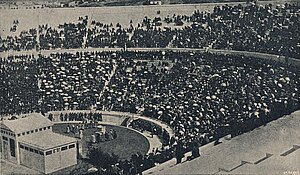History
The International Congresses of Classical Archaeology constitute the world’s most important forum for the archaeology of ancient Mediterranean cultures. However, they are also open to all adjacent disciplines that deal with Greco-Roman Antiquity from the Aegean Bronze Age to the end of Late Antiquity, and with the neighbouring cultures that were influenced by these (for example, Ancient History, Architectural History, Papyrology, Numismatics etc.). They have a history extending back a good 100 years, since the first congress was held in Athens in 1905. Since that time the congresses have been conducted almost uninterruptedly, in a 5-year cycle and alternating host cities in Europe, the Mediterranean region and the USA.
Following the caesura of the Second World War, the Associazione Internazionale di Archeologia Classica (AIAC), based in Rome, took on the congress’s patronage and co-ordination. The AIAC was founded in Rome on 5 May 1945, with the aim of re-enlivening, after catastrophic Second World War, the intensive international collaboration among the global archaeological research community which reached back to the start of the 19th century. It was also by courtesy of the AIAC that the world’s biggest archaeological research library, of the German Archaeological Institute (DAI) Rome, survived the post-war turmoil and was restored to the DAI in Rome in 1953. To this day, the AIAC is the sole international lobby for Classical Archaeology, with the primary aim of promoting research and information exchange across national and disciplinary boundaries. Numerous individual researchers and institutions throughout the world are members. All archaeological research institutes in Rome are represented on the steering committee, including the British School at Rome, the Deutsche Archäologische Institut Rom, the École Française de Rome, the American Academy of Rome and many others.
The International Congresses of Classical Archaeology primarily serve the intra-disciplinary exchange of new research findings and methodological approaches. However, current issues and research focuses are also integrated in their overriding themes. On a regular basis, the congresses set major stimuli and trajectories for continued research on the ancient world.
Congresses so far:
I. Athens 1905
II. Cairo 1909
III. Rome 1912
IV. Barcelona 1929
V. Algier 1930
VI. Berlin 1939
VII. Rome/Naples 1958
VIII. Paris 1963: Le rayonnement des civilisations grecque et romaine sur les cultures périphériques
IX. Damascus 1969: Orient, Grèce et Rome
X. Ankara/Izmir 1973: Anatolia in Classical Antiquity
XI. London 1978: Greece and Rome in the classical world
XII. Athens 1983: La Grèce classique et le monde classique
XIII. Berlin 1988: Der Hellenismus in der Archäologie
XIV. Tarragona 1993: La ciutat en el món romà
XV. Amsterdam 1998: Classical Archaeology towards the Third Millenium
XVI. Boston 2003: Common ground: archaeology, art, science and humanities
XVII. Rome 2008: Meetings Between Cultures in the Ancient Mediterranean
XVIII. Merida 2013: Centro y periferia en el mundo clásico
XIX. Cologne/Bonn 2018: Archaeology and economy in the Ancient World
Statistics
Congress participants
1235 congress participants from 44 countries
102 student assistants
Scientific programme
11 keynote lectures
128 panels
900 talks
114 poster
6 workshops
Speaker: 49 % male, 51 % female
Panel organiser: 45 % male, 55 % female
Travel grants
53 supported participants
40 % male, 60 % female
Supporting programme
6 excursions to Trier, Aachen, Mainz, Mayen, Xanten, Frankfurt
10 city tours in Cologne and Bonn
4 museum tours in Bonn



